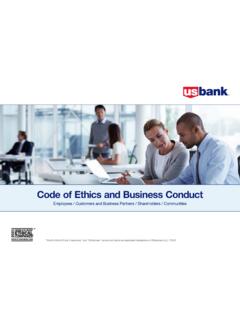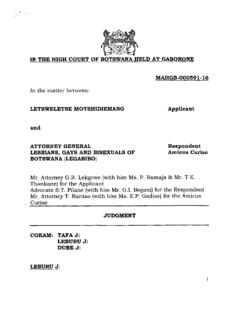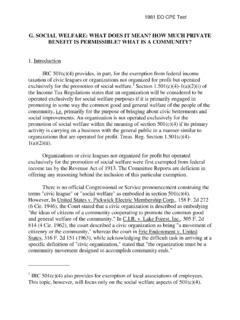Transcription of IRC 501(c)(5) Organizations - IRS tax forms
1 Exempt Organizations -Technical Instruction Program for FY 2003 IRC 501(c)(5) Organizations By John Francis Reilly, Carter C. Hull, and Barbara A. Braig Allen Exempt Organizations -Technical Instruction Program for FY 2003 IRC 501(c)(5) Organizations By John Francis Reilly, Carter C. Hull, and Barbara A. Braig Allen Overview Purpose IRC 501(c)(5) provides for the exemption from federal income tax of labor, agricultural, or horticultural Organizations . As of March 31, 2002, there were 58,962 Organizations recognized as tax-exempt under IRC 501(c)(5). This article will address the requirements an organization must meet to qualify for recognition as exempt under IRC 501(c)(5).
2 The Appendices contain checksheets and instructions for Project Code #207, 501(c)(5) Labor Organizations . Rules relating to the political campaign and lobbying activities of IRC 501(c)(5) are the subject of a separate article. In This Article This article contains the following topics. Topic See Page Overview 1 A. Statutory History 3 B.
3 Labor Organizations 4 1. Definition 4 2. Membership 5 3. Principal Purposes 8 4. Qualifying Activities 9 5. Non-qualifying Activities 15 6. Financial Aid to Members 24 C. Agricultural and Horticultural Organizations 25 1. Purpose Issues 25 a) Definitions 25 b) Principal Purposes 27 c) Qualifying Activities 28 d) Non-qualifying Activities 31 Continued on next page IRC 501(c)(5) Organizations page J-1 Exempt Organizations -Technical Instruction Program- for FY 2003 Overview, Continued In This Article, continued 2. Membership Issues 33 a) Qualifying Activities 33 b) Non-qualifying Activities 35 c) Sales Activities 36 D. Classification Problems 37 1. IRC 501(c)(5) v.
4 IRC 501(c)(3) 37 2. IRC 501(c)(5) v. IRC 501(c)(6) 39 3. Other Conflicts in Classification 41 E. Inurement 42 1. Inurement prohibition 42 2. Excess benefit under IRC 4958 42 Appendix A - Project #207 Checksheet: 501(c)(5) Labor Organization 43 Appendix B - Special Processing Instructions: Project Code 207 Labor Organizations 51 Appendix C - Project #207 Checksheet: 501(c)(5) Labor Organization Non-filers 53 Appendix D - Special Processing Instructions: Project Code 207 Labor Organizations Non-filers 61 Detailed Subject Directory 64 IRC 501(c)(5) Organizations page J-2 Exempt Organizations -Technical Instruction Program for FY 2003 A. Statutory History Tariff Act of 1909 An income tax exemption for labor agricultural or horticultural Organizations was first provided in the Corporation Excise Tax Act of 1909.
5 The legislative history of IRC 501(c)(5) and other relevant tax statutes provide a useful definition of labor Organizations for purposes of applying IRC 501(c)(5). Congress first exempted labor Organizations from the general corporate tax levied by the Tariff Act of 1909. Tariff Act of 1909, ch. 6, 38, 36 Stat. 113. The bill, as sent to the Senate Finance Committee, included the term "labor organization." The term was eliminated in committee as unnecessary. At the time the committee felt that the wording "fraternal beneficiary societies, ** operating under the lodge system and providing for the payment of life, sick, accident, and other benefits" was sufficient.
6 44 Cong. Rec. at 4148-49. Among others, the Brotherhood of Local Firemen expressed concern that their organization would not be exempt. These Organizations , which did not provide life, sick, accident, and other benefits to their members, might not be considered "beneficiary societies." 44 Cong. Rec. at 4154. The phrase "labor organization" consequently was added to the statute to cover Organizations that do not "make such provisions, and are not organized for those purposes." 44 Cong. Rec. at 4155. In 1913, passage of the first income tax act excluded "labor, agricultural, or horticultural Organizations " from income tax liability. Tariff Act of 1913, ch. 16, 11(G), 38 Stat.
7 172. Subsequent tax bills and revisions have maintained this language. In 1976, IRC 501(g) was added to the Code to define agriculture as the art or science of cultivating land, harvesting crops or aquatic resources, or raising livestock. The provision was enacted to clarify that harvesting aquatic resources should be recognized as an agricultural pursuit. The legislative history indicates that Organizations engaged in harvesting aquatic food were encountering difficulty in qualifying for reduced postal rates. See S. Rep. No. 94-938 at 419, 420, reprinted in 1976-3 (vol. 3) 457-458. IRC 501(c)(5) Organizations page J-3 Exempt Organizations -Technical Instruction Program- for FY 2003 B.
8 Labor Organizations 1. Definition What Is a "Labor Organization?" The term "labor" is commonly accepted as meaning the performance of service as employees. Rev. Rul. 78-288, 1978-2 179, citing Rev. Rul. 76-420, 1976-2 153. General usage defines a labor organization as: An association of workers Who have combined to protect or promote the interests of the members By bargaining collectively with their employers To secure better working conditions, wages, and similar benefits. The term embraces labor unions, councils, and committees. "Labor union" is a somewhat narrower term than "labor organization." Labor unions are labor Organizations , but not all labor Organizations are labor unions.
9 IRC 501(c)(5) labor Organizations do not need to be recognized labor unions. IRC 501(c)(5) Organizations page J-4 Exempt Organizations -Technical Instruction Program for FY 2003 B. Labor Organizations 2. Membership Composition A labor organization is generally composed of employees or representatives of the employees (collective bargaining agents) and similar groups. The composition of the organization is not as important as are the purposes for which it is formed and operated. Example: An apprenticeship committee consisted of representation by both employees and employers equally. The committee was organized primarily: To establish standards of employment for apprentices in various skilled crafts, To determine the qualifications necessary to become a journeyman, To aid in adjusting and settling disputes between the employer and the apprentice, and To cooperate with the local board of education in establishing supplementary classroom instruction pertaining to the apprentice's vocation.
10 The composition of the committee was not within the usual meaning of labor organization, , representatives of employees in the form of collective bargaining agents or similar employees. The primary objectives of the apprenticeship committee improved the lot of the apprentices by: Establishing standards as to wage requirements, Improving working conditions, Helping to settle disputes between apprentices and employers, Establishing the number of apprentices which will be employed in a trade, and Providing for on-the-job training with required supplemental education in the classroom. In addition, the committee was not operated for the profit of any individual.












